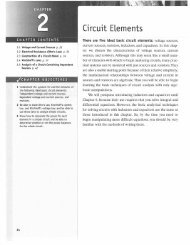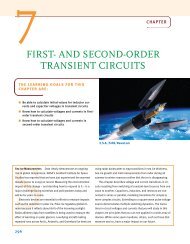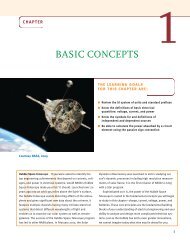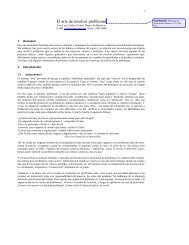Fundamentals of Electric Circuits
Fundamentals of Electric Circuits
Fundamentals of Electric Circuits
You also want an ePaper? Increase the reach of your titles
YUMPU automatically turns print PDFs into web optimized ePapers that Google loves.
3.2 Nodal Analysis 87<br />
Substituting Eq. (3.2.5) into Eq. (3.2.4) yields<br />
2v 2 v 2 2.4 1 v 2 2.4, v 1 2v 2 4.8 V<br />
From Eq. (3.2.3), we get<br />
Thus,<br />
■ METHOD 2 To use Cramer’s rule, we put Eqs. (3.2.1) to (3.2.3)<br />
in matrix form.<br />
From this, we obtain<br />
Similarly, we obtain<br />
¢ 1 <br />
¢ 2 <br />
<br />
<br />
<br />
<br />
<br />
<br />
¢ 3 <br />
<br />
<br />
<br />
v 3 3v 2 2v 1 3v 2 4v 2 v 2 2.4 V<br />
v 1 4.8 V, v 2 2.4 V, v 3 2.4 V<br />
£<br />
12 2 1<br />
0 7 1<br />
5 0 3 15<br />
12 2 1<br />
0 7 1<br />
3 12 1<br />
4 0 1<br />
5 2 0 15<br />
3 12 1<br />
4 0 1<br />
3 2 12<br />
4 7 0<br />
5 2 3 05<br />
3 2 12<br />
4 7 0<br />
3 2 1<br />
4 7 1<br />
2 3 1<br />
v 1<br />
§ £ v 2 § £<br />
v 3<br />
12<br />
0 §<br />
0<br />
(3.2.6)<br />
v 1 ¢ 1<br />
¢ , v 2 ¢ 2<br />
¢ , v 3 ¢ 3<br />
¢<br />
where ¢, ¢ 1 , ¢ 2 , and ¢ 3 are the determinants to be calculated as<br />
follows. As explained in Appendix A, to calculate the determinant <strong>of</strong><br />
a 3 by 3 matrix, we repeat the first two rows and cross multiply.<br />
3 2 1<br />
3 2 1 4 7 1<br />
¢ 3 4 7 1 3 5 2 3 15<br />
2 3 1 3 2 1 <br />
4 7 1 <br />
<br />
<br />
21 12 4 14 9 8 10<br />
84 0 0 0 36 0 48<br />
<br />
<br />
<br />
0 0 24 0 0 48 24<br />
<br />
<br />
<br />
0 144 0 168 0 0 24













